结构化学-多媒体版 李炳瑞
- 格式:ppt
- 大小:19.27 MB
- 文档页数:10

大 学 化 学Univ. Chem. 2022, 37 (4), 2106032 (1 of 5)收稿:2021-06-15;录用:2021-07-20;网络发表:2021-09-16*通讯作者,Emails:***************.cn(张冬菊);***********.cn(马玉臣)基金资助:国家自然科学基金(21773139, 21833004)•教学研究与改革• doi: 10.3866/PKU.DXHX202106032 问题式教学法在结构化学教学中的应用:一维势箱中的粒子张冬菊*,马玉臣*山东大学化学与化工学院,济南 250100摘要:一维势箱中的粒子是结构化学课程中的重要内容,包含的知识点多、涉及面广、综合性强,采用“问题式教学法”围绕薛定谔方程的求解和结果讨论进行问题设计,以提出问题为切入点,引导学生通过分析问题和解决问题实现众多知识点的有机关联,加深对量子力学基本原理的认识和理解,取得了较好的教学效果。
关键词:结构化学;问题式教学法;一维势箱中图分类号:G64;O6Application of Problem-Based Learning in Teaching of StructuralChemistry: A Particle in a One-Dimensional Potential BoxDongju Zhang *, Yuchen Ma *School of Chemistry and Chemical Engineering, Shandong University, Jinan 250100, China.Abstract: In the course of structural chemistry, “a particle in a one-dimensional box” is an important content, becauseit contains many concepts, involves a wide range of knowledge, and is highly comprehensive. Based on the “problem-based learning”, a series of problems were designed on solving the Schrödinger equation and the result discussion.Starting from asking the questions, students are guided to organically connect the knowledge points by analyzing andsolving problems, and to get an in-depth understanding of the basic principles of quantum mechanics. A good teachingeffect has been achieved.Key Words: Structural chemistry; Problem-based learning; One-dimensional potential well1 前言结构化学是化学类各本科专业的必修课,它是连接基础化学和高等化学的桥梁,课程理论性强、知识点多、内容抽象,且涉及较多的数学、物理知识,通常是学生认为难度较大的一门课程[1–4]。
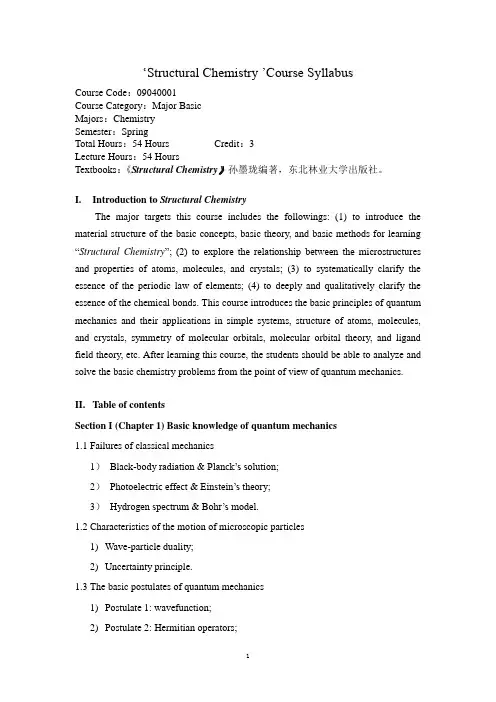
‘Structural Chemistry ’Course SyllabusCourse Code:09040001Course Category:Major BasicMajors:ChemistrySemester:SpringTotal Hours:54 Hours Credit:3Lecture Hours:54 HoursTextbooks:《Structural Chemistry》孙墨珑编著,东北林业大学出版社。
I.Introduction to Structural ChemistryThe major targets this course includes the followings: (1) to introduce the material structure of the basic concepts, basic theory, and basic methods for learning “Structural Chemistry”; (2) to explore the relationship between the microstructures and properties of atoms, molecules, and crystals; (3) to systematically clarify the essence of the periodic law of elements; (4) to deeply and qualitatively clarify the essence of the chemical bonds. This course introduces the basic principles of quantum mechanics and their applications in simple systems, structure of atoms, molecules, and crystals, symmetry of molecular orbitals, molecular orbital theory, and ligand field theory, etc. After learning this course, the students should be able to analyze and solve the basic chemistry problems from the point of view of quantum mechanics.II.Table of contentsSection I (Chapter 1) Basic knowledge of quantum mechanics1.1 Failures of classical mechanics1)Black-body radiation & Planck’s solution;2)Ph otoelectric effect & Einstein’s theory;3)Hydrogen spectrum & Bohr’s model.1.2Characteristics of the motion of microscopic particles1)Wave-particle duality;2)Uncertainty principle.1.3The basic postulates of quantum mechanics1)Postulate 1: wavefunction;2)Postulate 2: Hermitian operators;3)Postulate 3: Schrödinger equation;4)Postulate 4: linearity and superposition;5)Postulate 5: Pauli exclusion principle.1.4Applications of quantum mechanics in simple cases1)Free particle in one-dimensional (1D) box;2)Applications of the 1D-box model in simple chemical systems;3)Free particle in two-dimensional (2D) & three-dimensional (3D) box;4)Tunneling & scanning tunneling microscopy (STM).Section II (Chapter 2) Structures and properties of atoms2.1 One-electron atom: H atom1)The Schrödinger equation of H atoms;2)Solution of the Schrödinger equation of H atom.2.2Quantum numbers1)Principle quantum number, n;2)Angular momentum quantum number, l;3)Magnetic quantum number, m;4)Zeeman effect.2.3Wavefunction and electron cloud1)Radial distribution;2)Angular distribution;3)Spatial distribution.2.4 Structure of multi-electron atoms1)The Schrödinger equation of multi-electron atoms•Self-consistent field method;•Central field approximation.2)The building-up principles and electron configuration of multi-electron atoms•Pauli exclusion principle;•Principle of minimum energy;Hund’s rule.2.5Electron spin and Pauli exclusion principle2.6Atomic spectroscopy1)Orbital-spin coupling;2)Spectroscopic terms & term symbol;3)Derivation of atomic term.4)Hund’s rule on the spectroscopic terms;2.7Atomic properties1)Energy of ionization;2)Electron affinity;3)Electronegativity.Section III (Chapters 3-6) Structures and properties of molecules Chapter 3 Geometric structure of molecules─Molecular symmetry & symmetry point group3.1Symmetry elements and symmetry operations1)Symmetry elements and symmetry operations;2)Combination rules of symmetry elements;3.2Point groups & symmetry classification of molecules3.3Point groups & groups multiplication3.4Applications of molecular symmetry1)Chirality & optical activity;2)Polarity & dipole moment.Chapter 4 S tructure of biatomic molecules (X2 & XY)4.1 Linear variation method and structure of H2+ ion1) Shrödinger equation of H2+ ion;2) Linear variation method;3) Treatment of H2+ ion using linear variation method;4) Solutions of H2+ ion.4.2 Molecular orbital theory and diatomic molecules1) Molecular orbital theory;2) Structure of homonuclear diatomic molecules (X2);3) Structure of heteronuclear diatomic molecules (XY).4.3 Valence bond (VB) theory and H2 moleculeChapter 5 Structure of polyatomic molecules (A)5.1 Structure of Methane (CH4)1) Delocalized molecular orbitals of methane (CH4);2) Localized molecular orbitals of methane (CH4).5.2 Molecular orbital hybridization1) Theory of molecular orbital hybridization;2) Construction of hybrid orbitals;3) Structure of AB n molecules;4) Molecular stereochemistry: valence shell electron-pair repulsion (VSEPR)model.5.3 Delocalized molecular orbital theory─Hückel molecular orbital (HMO) theory1) HMO method & conjugated systems;2) HMO treatment for butadiene;3) HMO treatment for cyclic conjugated polyene (C n H n);4) Molecular diagrams;5) Delocalized π bonds.5.4 Structure of electron deficient molecules5.5 Symmetry of molecular orbitals and symmetry rules for molecular reactions5.6 Molecular spectroscopy1)Infrared absorption spectroscopy: molecular vibrations;2)Raman scattering spectroscopy: molecular vibrations;3)Fluorescence spectroscopy: electronic transitions;4)NMR spectroscopy: nuclear magnetic resonances.Chapter 6 Structure of polyatomic molecules (B), coordination compounds 6.1 Crystal field theory6.2 CO and N2 coordination complexes6.3 Organic metal complexes1) Zeise’s salts;2) Sandwich complexes.6.4 Clusters1) Transition-metal cluster compounds2) Carbon clusters and nanotubesSection IV (Chapters 7-9) Structure of crystalsChapter 7 Basics of crystallography7.1 Periodicity and lattices of crystal structure1) Characteristics of crystal structure;2) Lattices and unit cells;3) Bravais lattices and unit cells of crystals;4) Real crystals & crystal defects.7.2 Symmetry in crystal structure1) Symmetry elements and symmetry operations;2) Point groups (32) and space groups (230).7.3 X-Ray diffraction of crystals1) X-ray diffraction of crystals•Laue equation;•Bragg’s law;•Reciprocal lattice.2) Instrumentation of X-ray diffraction;3) Applications of X-Ray diffraction•Single crystal diffraction: crystal structure determination;•Powder diffraction: qualitative & quantitative analysis of crystalline materialsChapter 8 Crystalline solids, I: metals and alloys8.1 Close Packing of Spheres1) Close packing of identical spheres;2) Packing density;3) Interstices.8.2 Structures and Properties of Pure Metals8.3 Structures and Properties of AlloyChapter 9 Crystalline solids, II: ionic crystals9.1 Packing of Ions;9.2 Crystal Structure of Some Typical Ionic Compounds9.3 Trend of Variation of Ionic Radii9.4 Pauling Rule of Ionic Crystal Structure9.5 Crystals of Functional Materials1) Nonlinear optical materials;2) Magnetic materials;3) Conductive polymers;4) Semiconductors: band gap and photocatalysisIII.Table of ScheduleReferences[1] 王荣顺主编,东北师范大学等,《结构化学》,高等教育出版社,2003年。
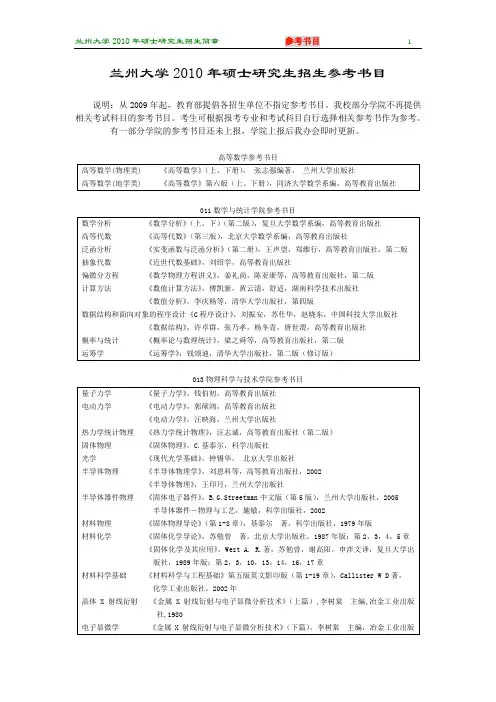
兰州大学2010年硕士研究生招生参考书目
说明:从2009年起,教育部提倡各招生单位不指定参考书目。
我校部分学院不再提供相关考试科目的参考书目。
考生可根据报考专业和考试科目自行选择相关参考书作为参考。
有一部分学院的参考书目还未上报,学院上报后我办会即时更新。
高等数学参考书目
011数学与统计学院参考书目
013物理科学与技术学院参考书目
016信息科学与技术学院参考书目
019化学化工学院参考书目
020生命科学学院参考书目
021资源环境学院参考书目
022草地农业科技学院参考书目
025大气科学学院参考书目
026土木工程与力学学院参考书目
027核科学与技术学院参考书目
031基础医学院参考书目
033口腔医学院参考书目
034公共卫生学院参考书目
035药学院参考书目
036第一临床医学院不提供参考书目037第二临床医学院不提供参考书目061文学院参考书目
062历史文化学院参考书目
064哲学社会学院参考书目
065外国语学院参考书目
066法学院不提供参考数目068经济学院参考书目
069管理学院参考书目
071新闻与传播学院参考书目
073政治与行政学院参考书目
075教育学院参考书目
076艺术学院参考书目。
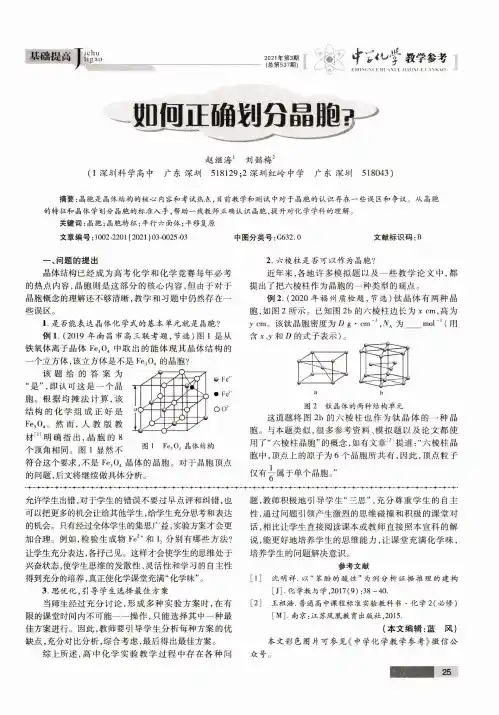
2021年第3期(总第537期),猶芝中爹教学参考-U卜」ZH〇N(,\l E HI \\l E .HAOM E(ANKAOM M正确划分晶胞?^赵继海1刘懿梅2(1深圳科学高中广东深圳518129;2深圳红岭中学广东深圳518043)摘要:晶胞是晶体结构的核心内容和考试热点,目前教学和测试中对于晶胞的认识存在一些误区和争议。
从晶胞 的特征和晶体学划分晶胞的标准入手,帮助一线教师正确认识晶胞,提升对化学学科的理解。
关键词:晶胞;晶胞特征;平行六面体;平移复原文章编号:1002-2201 (2021) 03>0025>03 中图分类号:G632.0 文献标识码:B一、问题的提出晶体结构已经成为高考化学和化学竞赛每年必考 的热点内容,晶胞则是这部分的核心内容,但由于对于 晶胞概念的理解还不够清晰,教学和习题中仍然存在一 些误区。
1.是否能表达晶体化学式的基本单元就是晶胞?例1. (2019年南昌市高三联考题,节选)图1是从 铁氧体离子晶体Fe304中取出的能体现其晶体结构的 一个立方体,该立方体是不是Fe304的晶胞?该题给的答案为“是”,即认可这是一个晶胞。
根据均摊法计算,该结构的化学组成正好是Fe3〇4。
然而,人教版教材[1]明确指出,晶胞的8个顶角相同。
图】显然不符合这个要求,不是Fe304晶体的晶胞。
对于晶胞顶点 的问题,后文将继续做具体分析。
2.六棱柱是否可以作为晶胞?近年来,各地许多模拟题以及一些教学论文中,都 提出了把六棱柱作为晶胞的一种类型的观点。
例2.(2020年福州质检题,节选)钛晶体有两种晶 胞,如图2所示。
已知图2b的六棱柱边长为* cm,高为y cm。
该钛晶胞密度为g •cm—3,7V a为____m o r1(用含;和的式子表7K)。
^13图2钛晶体的两种结构单元这道题将图2b的六棱柱也作为钛晶体的一种晶胞。
与本题类似,很多参考资料、模拟题以及论文都使用了“六棱柱晶胞”的概念,如有文章[2]提道:“六棱柱晶 胞中,顶点上的原子为6个晶胞所共有,因此,顶点粒子仅有+属于单个晶胞,允许学生出错,对于学生的错误不要过早点评和纠错,也 可以把更多的机会让给其他学生,给学生充分思考和表达 的机会。
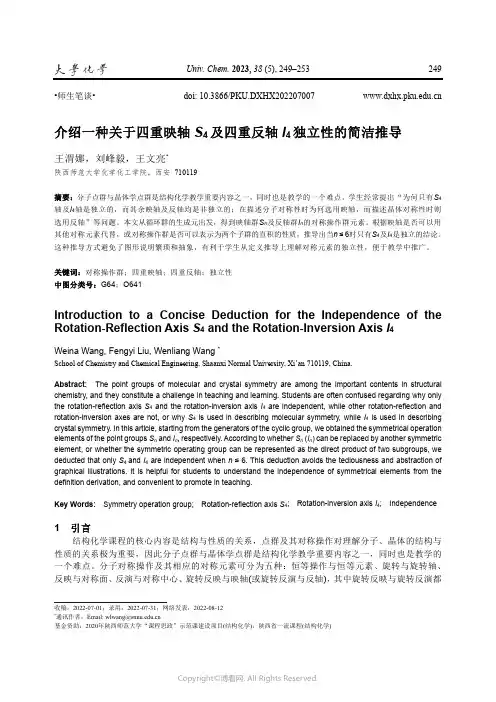
Univ. Chem. 2023, 38 (5), 249–253 249收稿:2022-07-01;录用:2022-07-31;网络发表:2022-08-12 *通讯作者,Email:***************.cn基金资助:2020年陕西师范大学“课程思政”示范课建设项目(结构化学);陕西省一流课程(结构化学)•师生笔谈• doi: 10.3866/PKU.DXHX202207007 介绍一种关于四重映轴S 4及四重反轴I 4独立性的简洁推导王渭娜,刘峰毅,王文亮*陕西师范大学化学化工学院,西安 710119摘要:分子点群与晶体学点群是结构化学教学重要内容之一,同时也是教学的一个难点。
学生经常提出“为何只有S 4轴及I 4轴是独立的,而其余映轴及反轴均是非独立的;在描述分子对称性时为何选用映轴,而描述晶体对称性时则选用反轴”等问题。
本文从循环群的生成元出发,得到映轴群S n 及反轴群I n 的对称操作群元素。
根据映轴是否可以用其他对称元素代替,或对称操作群是否可以表示为两个子群的直积的性质,推导出当n ≤ 6时只有S 4及I 4是独立的结论。
这种推导方式避免了图形说明繁琐和抽象,有利于学生从定义推导上理解对称元素的独立性,便于教学中推广。
关键词:对称操作群;四重映轴;四重反轴;独立性 中图分类号:G64;O641Introduction to a Concise Deduction for the Independence of the Rotation-Reflection Axis S 4 and the Rotation-Inversion Axis I 4Weina Wang, Fengyi Liu, Wenliang Wang *School of Chemistry and Chemical Engineering, Shaanxi Normal University, Xi’an 710119, China.Abstract: The point groups of molecular and crystal symmetry are among the important contents in structural chemistry, and they constitute a challenge in teaching and learning. Students are often confused regarding why only the rotation-reflection axis S 4 and the rotation-inversion axis I 4 are independent, while other rotation-reflection and rotation-inversion axes are not, or why S 4 is used in describing molecular symmetry, while I 4 is used in describing crystal symmetry. In this article, starting from the generators of the cyclic group, we obtained the symmetrical operation elements of the point groups S n and I n , respectively. According to whether S n (I n ) can be replaced by another symmetric element, or whether the symmetric operating group can be represented as the direct product of two subgroups, we deducted that only S 4 and I 4 are independent when n ≤ 6. This deduction avoids the tediousness and abstraction of graphical illustrations. It is helpful for students to understand the independence of symmetrical elements from the definition derivation, and convenient to promote in teaching.Key Words: Symmetry operation group; Rotation-reflection axis S 4; Rotation-inversionaxis I 4; Independence1 引言结构化学课程的核心内容是结构与性质的关系,点群及其对称操作对理解分子、晶体的结构与性质的关系极为重要,因此分子点群与晶体学点群是结构化学教学重要内容之一,同时也是教学的一个难点。
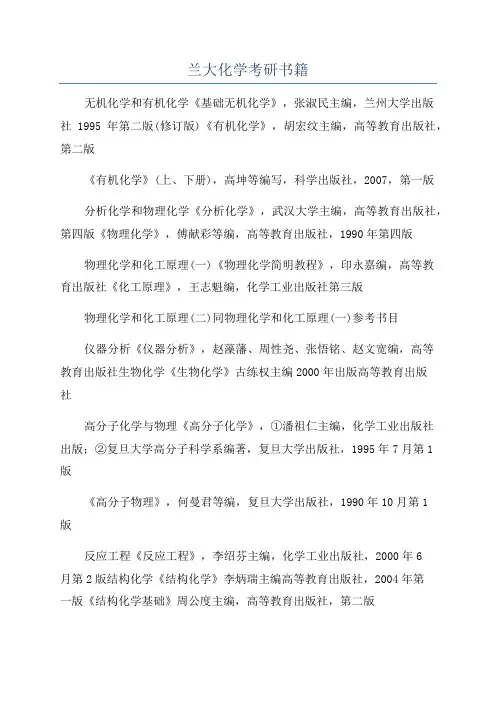
兰大化学考研书籍无机化学和有机化学《基础无机化学》,张淑民主编,兰州大学出版社1995年第二版(修订版)《有机化学》,胡宏纹主编,高等教育出版社,第二版《有机化学》(上、下册),高坤等编写,科学出版社,2007,第一版分析化学和物理化学《分析化学》,武汉大学主编,高等教育出版社,第四版《物理化学》,傅献彩等编,高等教育出版社,1990年第四版物理化学和化工原理(一)《物理化学简明教程》,印永嘉编,高等教育出版社《化工原理》,王志魁编,化学工业出版社第三版物理化学和化工原理(二)同物理化学和化工原理(一)参考书目仪器分析《仪器分析》,赵藻藩、周性尧、张悟铭、赵文宽编,高等教育出版社生物化学《生物化学》古练权主编2000年出版高等教育出版社高分子化学与物理《高分子化学》,①潘祖仁主编,化学工业出版社出版;②复旦大学高分子科学系编著,复旦大学出版社,1995年7月第1版《高分子物理》,何曼君等编,复旦大学出版社,1990年10月第1版反应工程《反应工程》,李绍芬主编,化学工业出版社,2000年6月第2版结构化学《结构化学》李炳瑞主编高等教育出版社,2004年第一版《结构化学基础》周公度主编,高等教育出版社,第二版化学信息学《化学信息学》缪强主编,2006年4月,高等教育出版社化学基础实验《大学化学实验-基本知识与技术》《大学化学实验-基础化学实验Ⅰ》《大学化学实验-基础化学实验Ⅱ》《大学化学实验-附录》,2004年,兰州大学出版社药物化学《药物化学》,郑虎主编,人民卫生出版社,2003年第五版◆化学工艺(081702)01工业催化02化学反应工程与工艺03化工分离04可再生资源开发技术05环保化学工艺与技术06绿色化学工艺与技术07高分子材料工艺与工程◆应用化学(081704)01环境放射化学02应用有机化学03催化剂与催化技术04工业过程分析05分离过程化学06精细化学品化学07应用无机化学①101思想政治理论②201英语一③302数学二④813物理化学和化工原理(一)(各占50%)复试科目:无机化学和有机化学、化学基础实验、专业英语同等学力加试:反应工程化学综合①101思想政治理论②201英语一③302数学二④813物理化学和化工原理(一)(各占50%)复试科目:无机化学和有机化学、化学基础实验、专业英语同等学力加试:仪器分析化学综合。